We had a good sleep through the night and since we were going to stay in the same place for another day without the rush to pack our stuff, we had the luxury of waking up later. After the wash-up, we were ready to depart for the Kyoto Station (京都駅), by taking the train on the JR Nara Line from Tofukuji JR Station (東福寺駅).
At the Kyoto Station, we went to Cafe Espressamente Illy to have our breakfast, which is an international chain that serves authentic Italian coffee. The interior of the cafe is segregated into smoking and non-smoking area. Most of us ordered their standard sandwich and toast set, which is served with either coffee or tea.
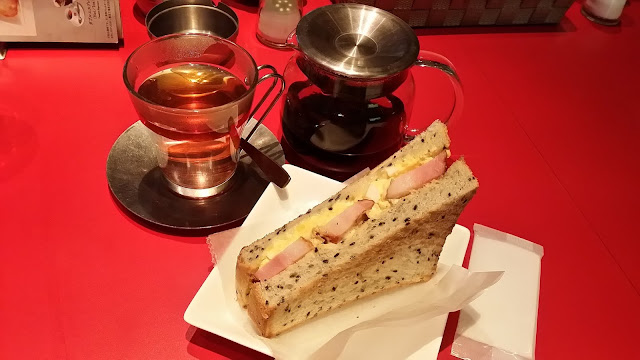 |
| Sandwich breakfast set |
After our breakfast, we set off to the subway station, to take the train via the Karasuma Line to our first attraction of the day,
Kyoto Imperial Palace (京都御所).
 |
| Waiting for the train at Kyoto Subway Station |
 |
| Kyoto Subway Station |
Kyoto Imperial Palace (京都御所)
The
Kyoto Imperial Palace (京都御所) is the former residence of the Japanese Emperors and their imperial families, until the Meiji Restoration in 1868 when the capital was shifted to Tokyo. Today, the compound is open to public to visit. The palace is located within a very big park called the Kyoto Imperial Park (京都御苑), which also encompasses the Sento Imperial Palace (仙洞御所), the Imperial Household Agency Kyoto Office and several other shrines.
We alighted at the Imadegawa Subway Station (今出川駅), and then walked for another 5 minutes to the Inui-gomon Gate (乾御門) of the Kyoto Imperial Park (京都御苑). From there, we followed along the wide gravel-filled pathway to the main entrance of the Kyoto Imperial Palace (京都御所), the Seisho-mon Gate (清所門).
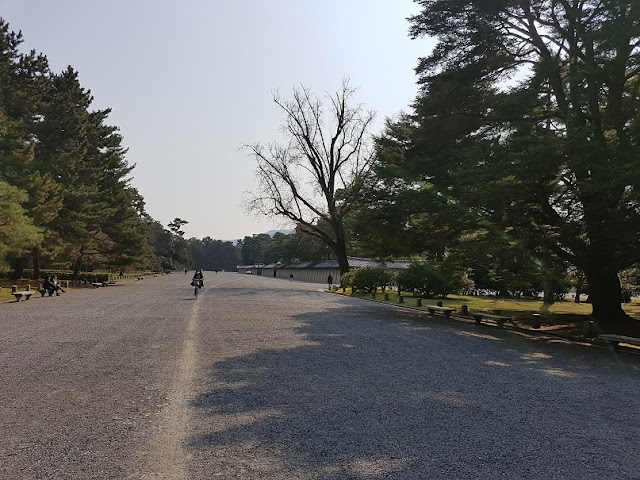 |
| Pathway towards the Kyoto Imperial Palace |
 |
| The main entrance, Seisho-mon Gate |
Entrance to the Kyoto Imperial Palace (京都御所) is free of charge and visitors do not need to follow any guided tours. Although having said that, we are not really allowed to roam freely in the compound, but to follow a dedicated visitor pathway. Note that visitors are also not allowed to enter the buildings. After the security scanning of our belongings, we were issued each a visitor pass and from there we began our tour.
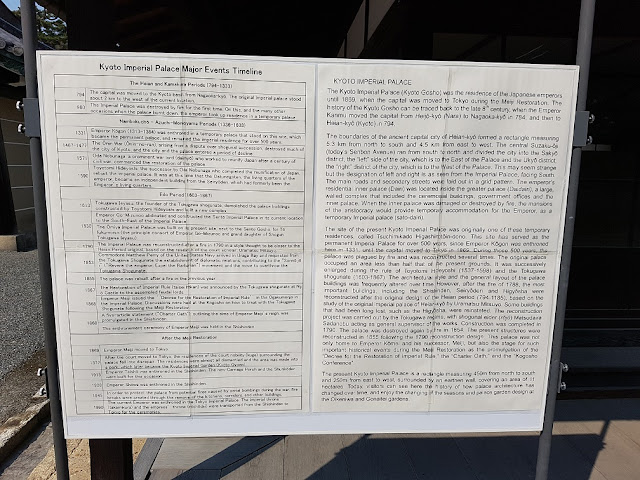 |
| Introduction to Kyoto Imperial Palace |
 |
| Map of Kyoto Imperial Palace |
The first place that we encountered was the Okurumayose (御車寄), which was the entrance where the officials and nobles had to pass through to enter the inner palace.
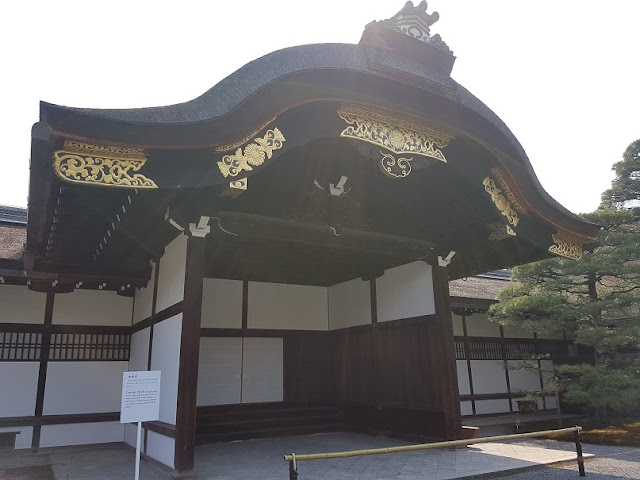 |
| Okurumayose |
 |
| Introduction of Okurumayose |
Over here, there's a porch for them to park their carriage. One would also noticed the Chrysanthemum Seal (菊紋) used as designs on most of the building's architecture. The Chrysanthemum Seal (菊紋) is actually the Imperial Seal of Japan and symbol of the Imperial Family. Immediately after this is the Shodaibunoma (諸大夫の間), which was the waiting room for the officials and nobles to attend the court or seek audience with the Emperor.
 |
| Shodaibunoma |
Interestingly, there are 3 different rooms (Room of the Cherry Trees, Cranes and Tigers) for officials of different ranks.
 |
| Photos of the 3 different rooms |
 |
| Pictures of Cherry Blossoms, Cranes and Tigers on the screens |
Next, we passed by the Shinmikurumayose (新御車寄), which was a new carriage porch built for the enthronement ceremony of Emperor Taisho (大正天皇) in 1915.
 |
| Shinmikurumayose |
 |
| Looking at Shinmikurumayose from far |
We walked further to the southern end, which the grand entrance of the red-coloured Jomei-mon Gate (承明門) is located.
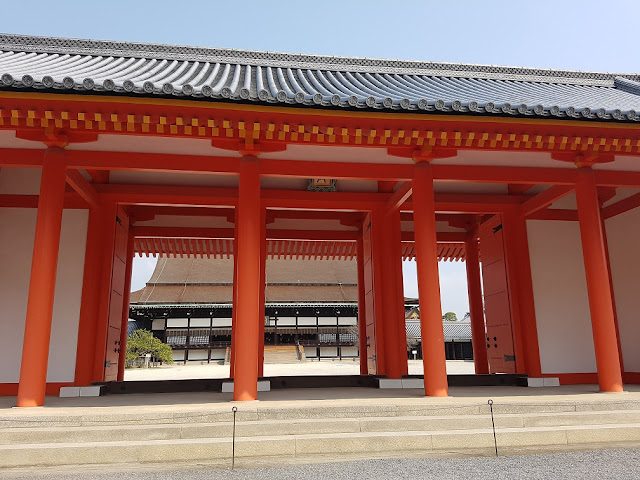 |
| Jomei-mon Gate |
To the east side of the Shishinden (紫宸殿) is the Shunkoden (春興殿), a wooden structure with copper roof, which enshrined the Sacred Mirror used during the enthronement ceremony of Emperor Taisho (大正天皇).
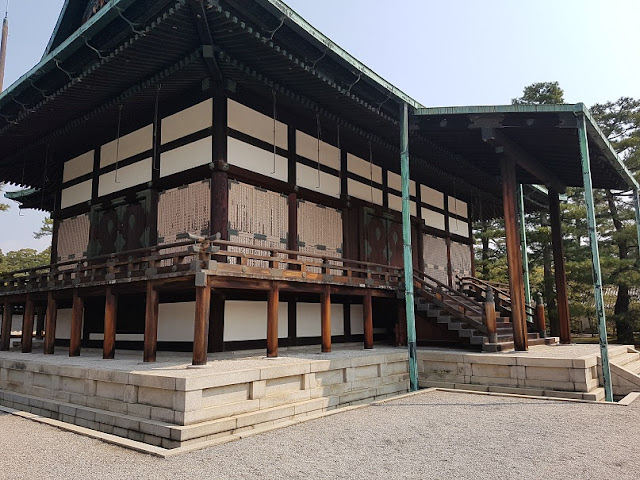 |
| Shunkoden |
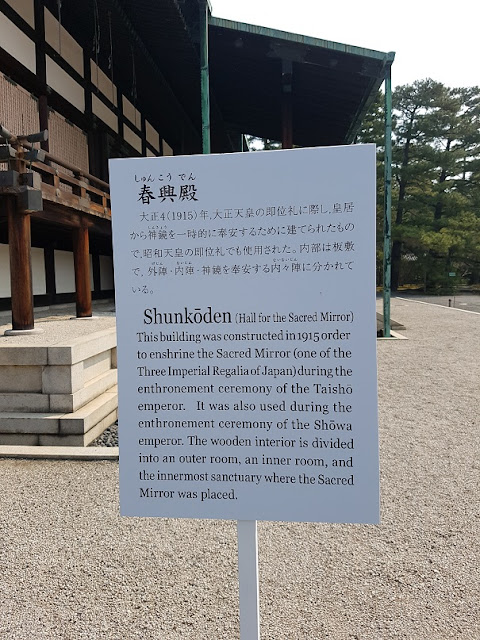 |
| Introduction to Shunkoden |
We followed the pathway to the Seiryoden (清涼殿), which was a place to conduct rites and rituals. Originally it was the living quarter of the Emperor and the place to conduct official court affairs, until the Otsunegoten (御常御殿) was built.
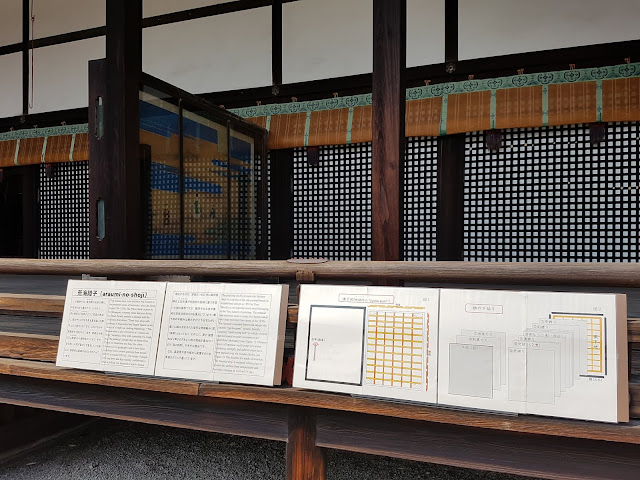 |
| Seiryoden |
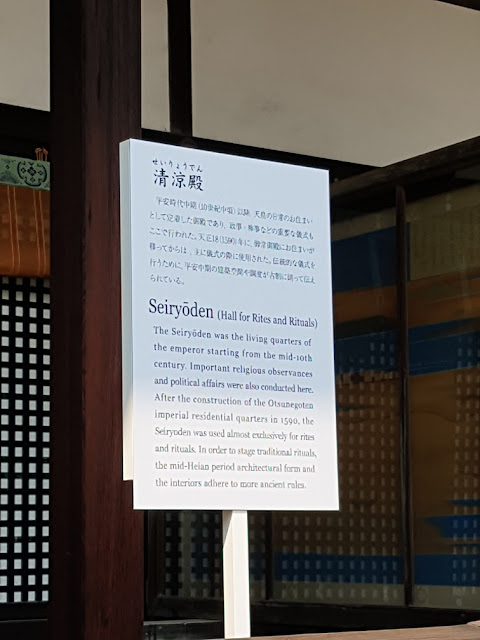 |
| Introduction to Seiryoden |
After this, we passed by the imperial garden, which has a large pond (Oikeniwa 御池庭) and waterways within.
 |
| Oikeniwa |
Just opposite the pond is the Kogosho (小御所), which was a place to hold ceremonies and imperial audiences with officials and nobles.
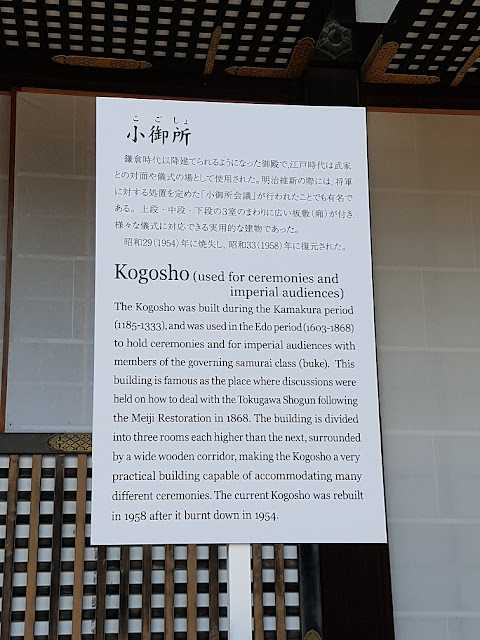 |
| Kogosho |
We followed the pathway and exited the palace. We headed to the north-western end of the park, where they were many bloomed cherry trees near the Konoe Pond. So far that was the first time in Japan we saw so many fully bloomed cherry trees. We were very excited and spent a long time over the spot to take photos of the flowers. We also saw many locals having picnic over here to enjoy the scenery.
 |
| Cherry Blossom near Kanoe Pond |
Kinkaku-ji Temple (金閣寺)
We exited the Kyoto Imperial Park (京都御苑) from the north and took the Kyoto City Bus 102 from the nearby Imadegawa Station bus stop to the Kinkakuji-michi bus stop. We walked for another 5 minutes to visit our next attraction, the
Kinkaku-ji Temple (金閣寺) (officially Rokuon-ji Temple 鹿苑寺), also known as the Golden Pavilion.
 |
| Introduction to Kinkaku-ji Temple |
Kinkaku-ji Temple (金閣寺) is an UNESCO World Heritage Site and a very popular attraction in Kyoto. It can trace its history back to 1397 when it used to be part of a villa, then converted to a Zen Buddhist temple. During the Onin War, all complexes except the pavilion were burnt down. Then in 1950, the pavilion was burnt down too. The Golden Pavilion that we would see today was rebuilt from 1955.
It was a fair bit of walking from the rest area to the ticket office. We queued for a while to buy the entrance tickets.
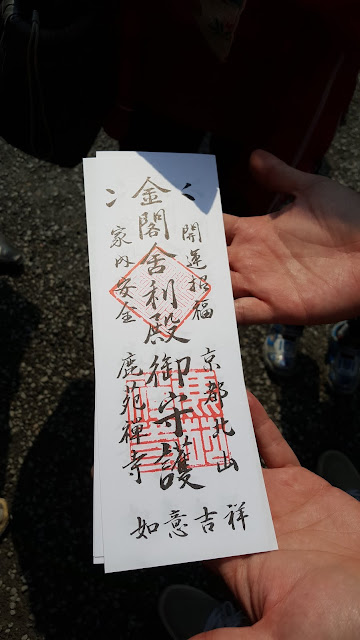 |
| Interesting entrance ticket that looks like a talisman |
After which, it was another short distance before we reached the Kyoko-chi Pond (鏡湖池). The magnificent Golden Pavilion resides by the pond, which its reflection on the water surface and against the backdrop of the mountains makes it the most picturesque view in Kyoto.
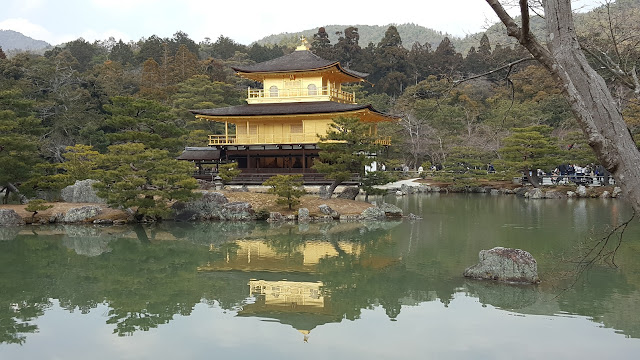 |
| View of the Golden Pavilion across the pond |
The pavilion has 3 levels. The top 2 levels are covered with pure gold leaf, thus giving its name. The 1st level houses the statues of Shaka Buddha and Yoshimitsu, which was visible from outside. The 2nd level houses the statues of a seated Kannon Bodhisattva surrounded by the Four Heavenly Kings. The 3rd level is capped with a golden phoenix.
The spot we were standing was packed with visitors trying to take photos of the scenery. After we were done, we followed the pathway further down. All visitors were to follow the pathway in the clockwise loop towards the exit.
 |
| Side view of the Golden Pavilion |
 |
| Rear view of the Golden Pavilion |
Along the way, we passed by other spots such as the Anmintaku Pond (安民沢) and the Fudodo (不動堂), before reaching the same rest area, where there's stalls selling souvenirs and refreshments.
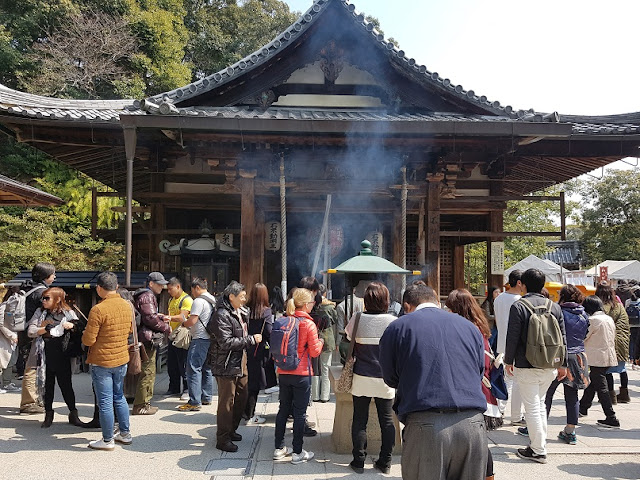 |
| Fudodo |
Lunch at Dining Bar Geronimo
After we exited the Kinkaku-ji Temple (金閣寺), it was already lunch time. We walked towards the main street where there's row of restaurants and cafes. After we paced up and down the street, we decided to visit the Dining Bar Geronimo.
 |
| Dining Bar Geronimo |
The restaurant was quite unique, which has a native American and cowboy theme.
 |
| The bar table |
They sell western and Japanese food, as well as alcoholic drinks, which is good place for a chill-out at night. We ordered a variety of food, such as sausage spaghetti, beef burger set and soba set. The food portion was just nice and tasty too.
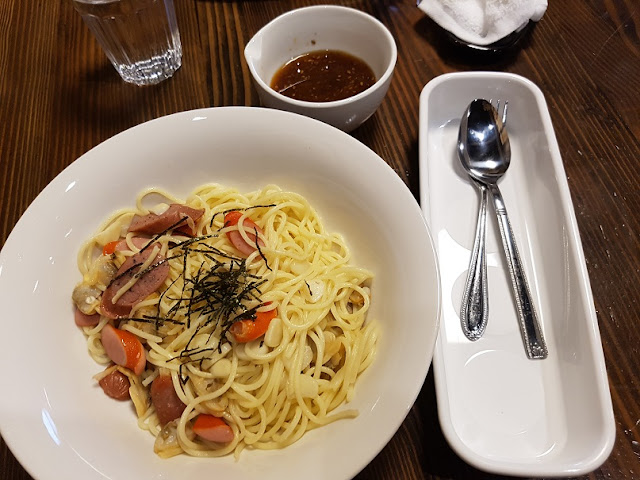 |
| Sausage Spaghetti |
 |
| Soba Set |
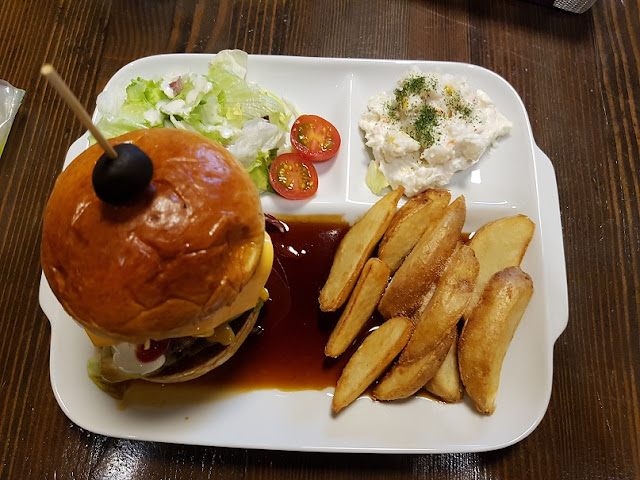 |
| Beef Burger Set |
Arashiyama (嵐山)
After our lunch, we set off to the next stop,
Arashiyama (嵐山), which is a touristy scenic district located at the west of the city. From the nearby bus stop, we took the Kyoto City Bus 205 to the Nishinokyo Enmachi bus stop. From there, it was a short distance walk to the Emmachi JR Station (円町駅). We took the JR Sagano Line to the Saga Arashiyama JR Station (嵯峨嵐山駅).
 |
| Saga Arashiyama JR Station |
After we exited the station, we followed the crowd towards the main street, which is considered the heart of the Arashiyama (嵐山) district. There are many restaurants, cafes and shops selling snacks and souvenirs.
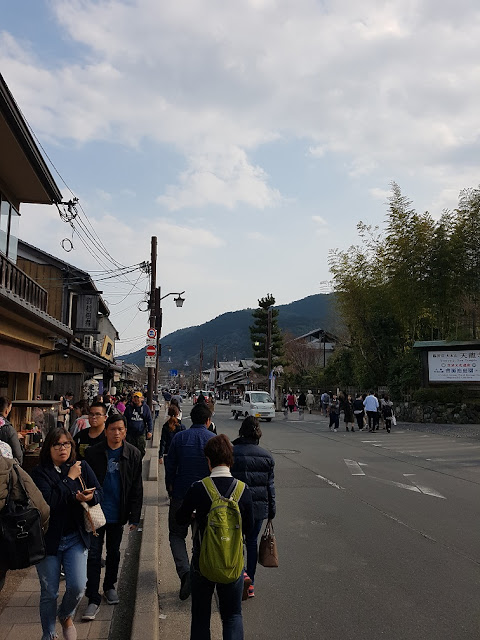 |
| Arashiyama Main Street near Tenryu-ji Temple |
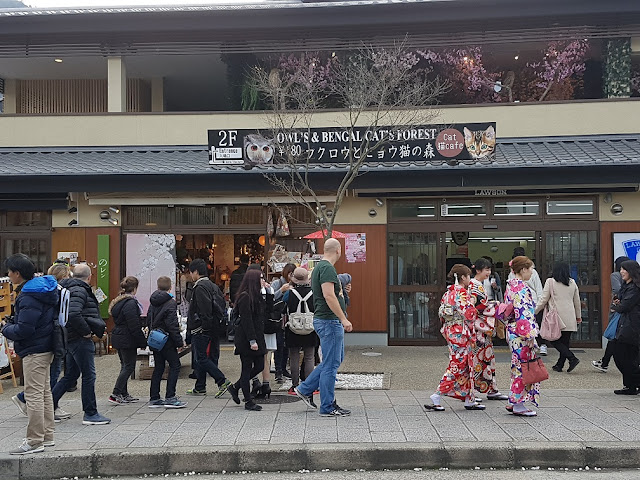 |
| Cat & Owl Cafe |
We spent some time shopping along the street, until we reached the Katsura River (桂川) to the south.
Togetsukyo Bridge (渡月橋)
At the river, there's a bridge across it, which is known as the Togetsukyo Bridge (渡月橋). This is one of the iconic landmark of Arashiyama (嵐山). The bridge has a long history and it is built with wood. On top of it, one could enjoy the scenery of the river, as well as the surrounding mountains. We crossed the bridge to the other side of the river bank, which is a small island that encompass the Arashiyama Nakonoshima Park (嵐山公園中之島地区).
 |
| Crossing the Togetsukyo Bridge |
 |
| View of Togetsukyo Bridge from the Nakonoshima Park |
The island has rows of cherry trees planted along the riverside, but only a few had bloomed. Otherwise, it would have been a magnificent view.
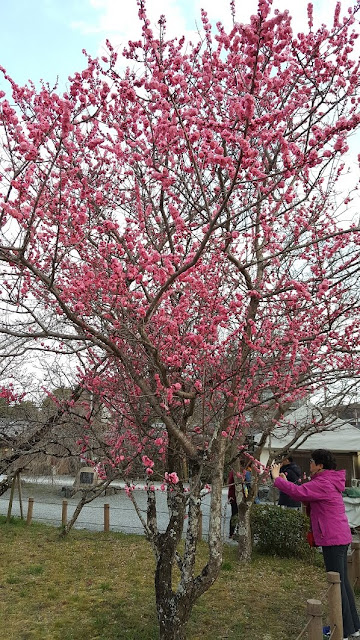 |
| Cherry Blossom |
Just further south from the island, one could also visit the Iwatayama Monkey Park (嵐山モンキーパーク) located on the slope of the mountain. However, we did not visit the Monkey Park, but we bought some snacks on the island and rested along the riverside, enjoying the breeze and the scenery.
Arashiyama Bamboo Grove (嵐山竹林)
After the rest, we crossed the bridge and headed back to the main street. We walked further north until we reached the
Tenryu-ji Temple (天龍寺), which is another UNESCO World Heritage Site. Our initial plan was to visit the temple, but as it was already near to their closing time, thus we decided not to visit it. We headed for our next and last attraction, the Bamboo Grove, which is located just north of the Tenryu-ji Temple (天龍寺). It wasn't difficult to find the pathway into the Bamboo Grove from the main street, as there were clear signage and we also simply followed the crowd.
The
Bamboo Grove is the top attraction in Arashiyama (嵐山), the main reason why tourists visit Arashiyama (嵐山). The scenery in the Bamboo Grove is one of its kind in the world, with the towering bamboo plants along both sides of the pathway.
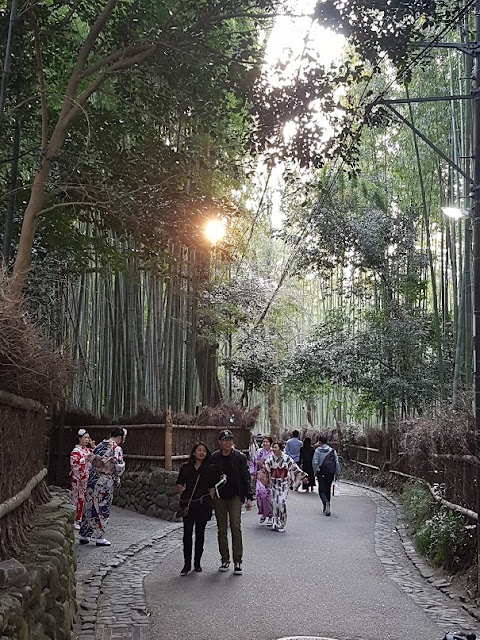 |
| Entering the Arashiyama Bamboo Grove |
 |
| Northern exit of Tenryu-ji Temple towards to Bamboo Grove |
The pathway is not very long, only around 500m in length. The pathway is also walk-able for most people, even for people with baby strollers, with gentle slopes in some parts. We also saw a couple taking wedding photo shot in the Bamboo Grove.
After the stroll and photo-taking along the pathway, we returned to the start point near the Nonomiya Shrine (野宮神社). We wanted to visit the restroom, and we were told that the nearest one is at the Saga Park (嵯峨公園) across the other side of the nearby railway track. We headed north of the Nonomiya Shrine (野宮神社) and after crossing the railway track, we found another patch of the Bamboo Grove by the pathway. The pathway in the area allows visitors to be closer to the bamboo plants, which was another different experience.
 |
| Waiting to cross the railway track north of Nonomiya Shrine |
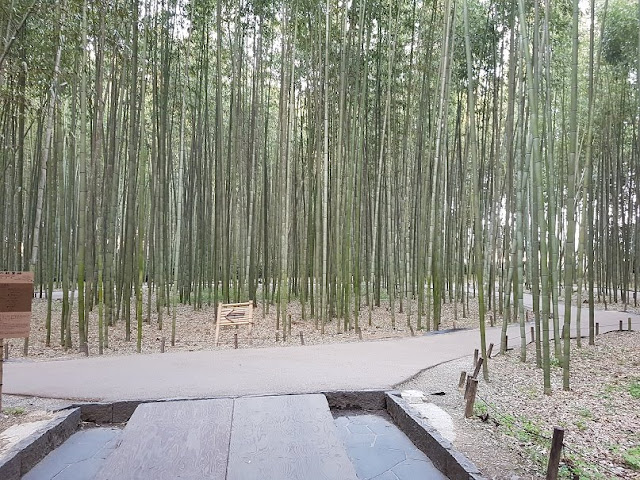 |
| Another patch of Bamboo Grove north of the railway track |
Along the way to the Saga Park (嵯峨公園), we had another surprise, which we saw a couple of Maiko riding on a
rickshaw.
 |
| Couple of Maiko on rickshaw |
After our restroom visit, it was time to bid farewell and return to the city. We walked towards Saga Arashiyama JR Station (嵯峨嵐山駅) and along the way passed by the backyard of a residential house, where they had a fully bloomed cherry tree. It was so beautiful that we stopped by to take photos of it.
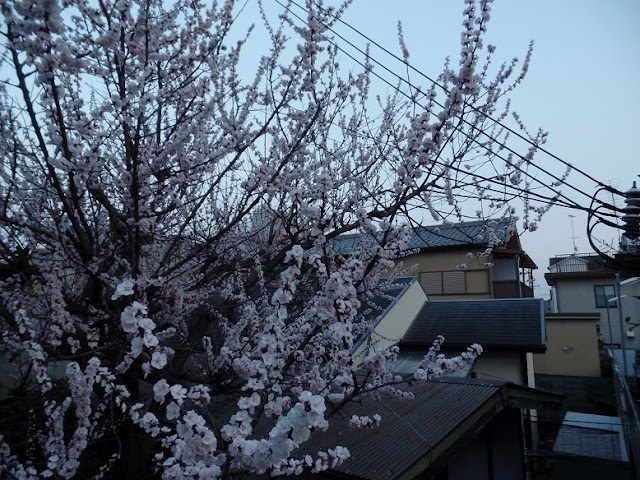 |
| Cherry Blossom |
Dinner at Kyoto Nishiki Warai (京都錦 わらい) @ Kyoto Station Building
From Saga Arashiyama JR Station (嵯峨嵐山駅), we took the train via JR Sagano Line back to the Kyoto Station (京都駅). Our original plan was to eat Ramen at the famous Kyoto Ramen Street located at the 10th floor of the Kyoto Station Building. Upon reaching there, we saw long queues at every Ramen restaurants. Instead, we went to The Cube Gourmet Street located at the 11th floor and chose to have our dinner at Kyoto Nishiki Warai (京都錦 わらい). The restaurant specialised in Okonomiyaki and Teppanyaki, which is a branch of the original restaurant located in the Nishiki Market (錦市場).
 |
| Kyoto Nishiki Warai |
We were seated in 2 tables, which come with the hot iron plate. They had English menu, so it wasn't any issue for us to order the food. We ordered their Kyoto-styled and Pork Okonomiyaki, Gyoza, grilled chicken and the Yakisoba (fried noodles).
 |
| Okonomiyaki |
The food was all served cooked and placed on the hot iron plate to keep them hot. We were each given a spatula to "stir fry" the noodles and cut the Okonomiyaki into smaller pieces.
 |
| Yakisoba |
Overall the food was delicious and the service of the staff were good too.
After dinner, we strolled along the "Grand Staircase" of Kyoto Station Building, which ranges from the 1st to the 12th floor. There are approximately 15,000 LED lights that will illuminate at night, forming different dynamic decorations and designs.
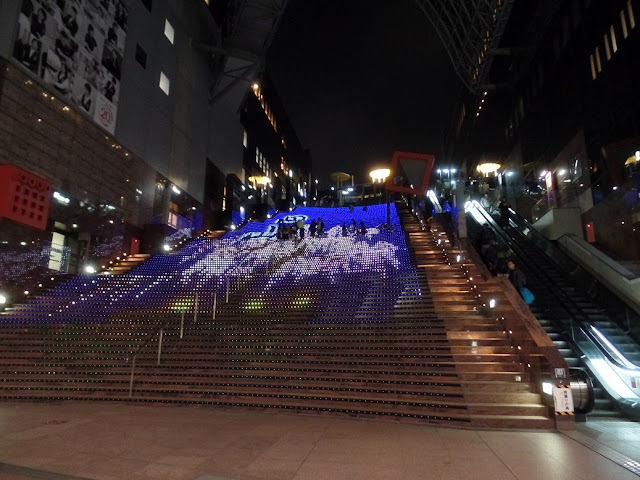 |
| The Grand Staircase |
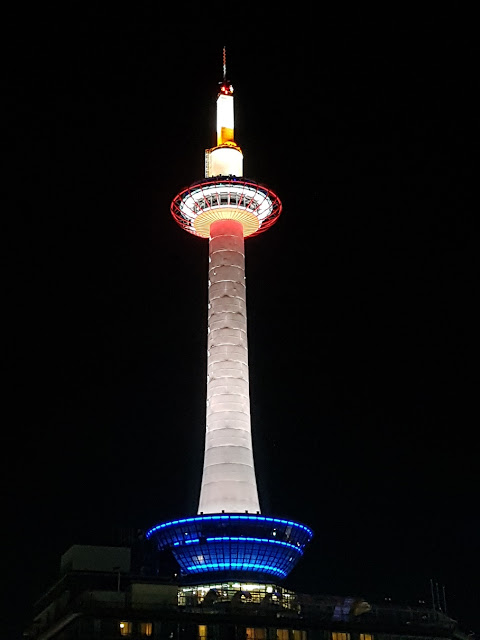 |
| View of Kyoto Tower at night |
After this, it was late already, we decided to call it a day and return to our Airbnb house.















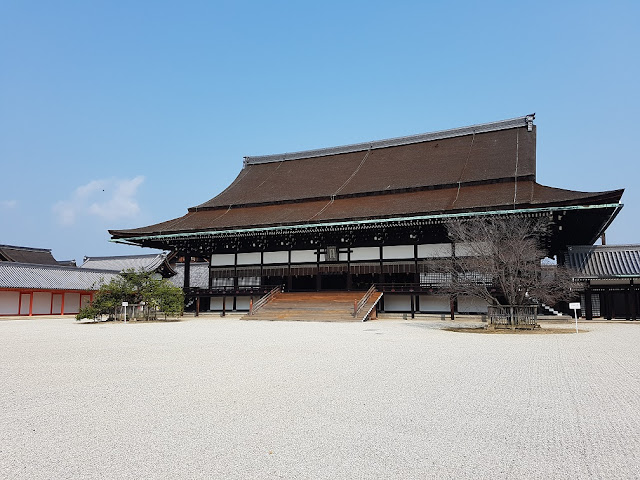

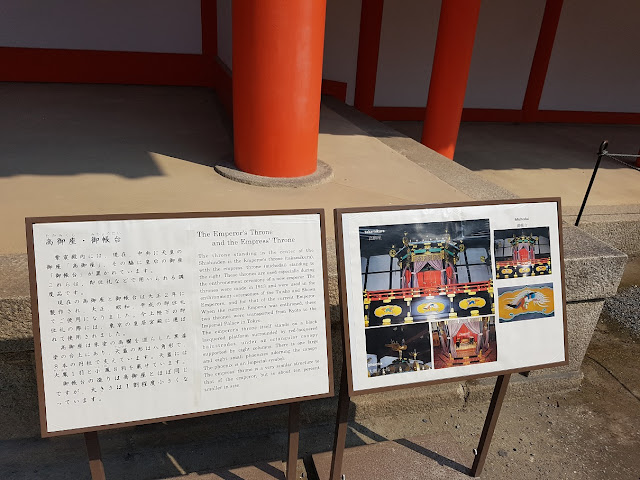






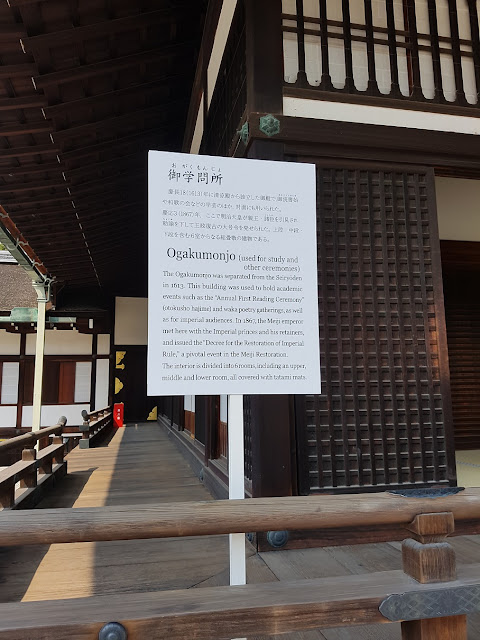







































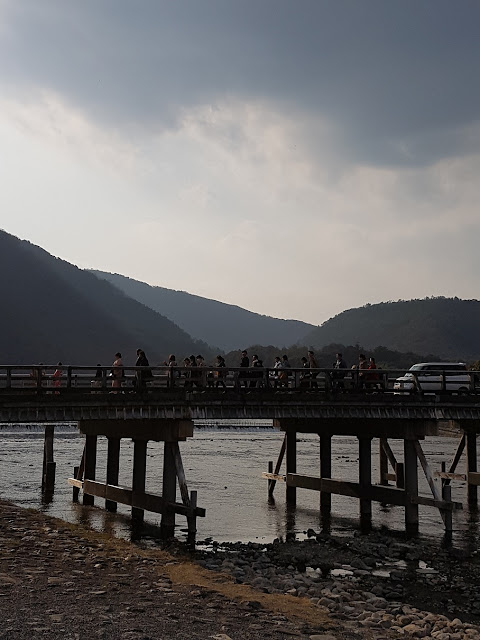
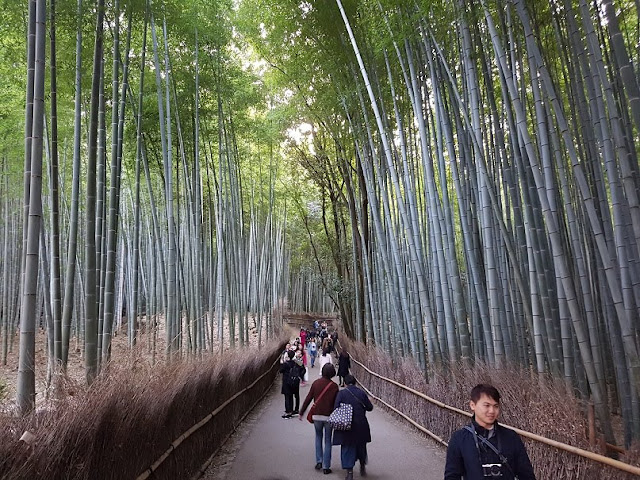
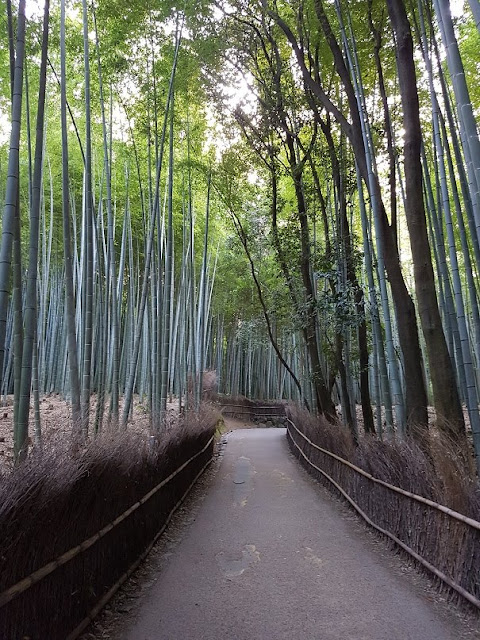
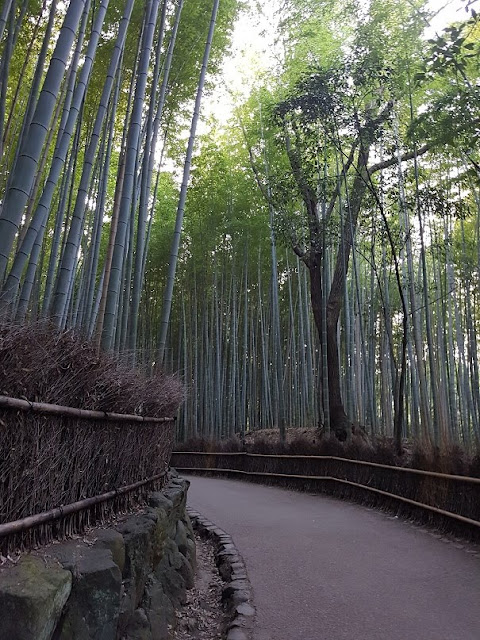
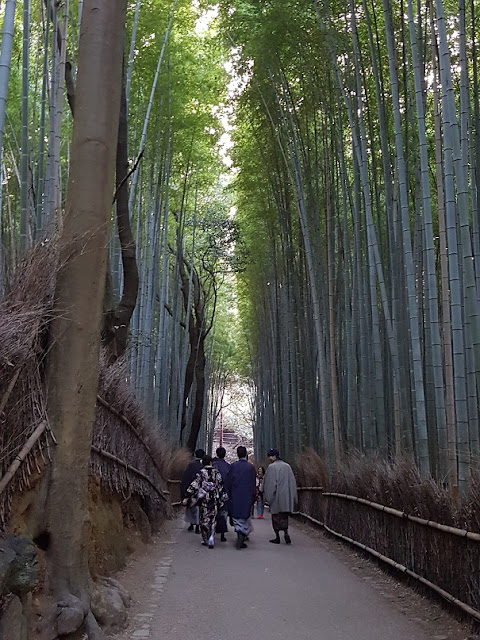
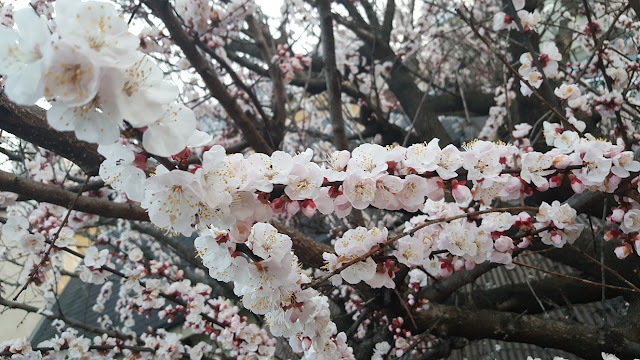

No comments:
Post a Comment